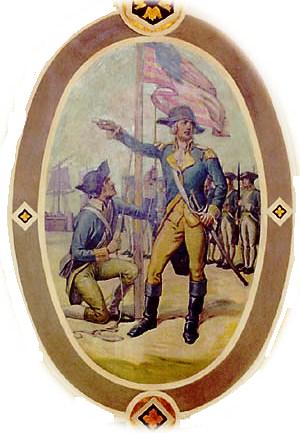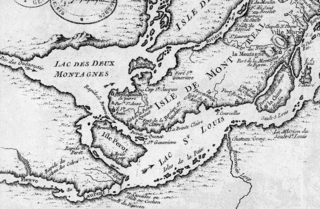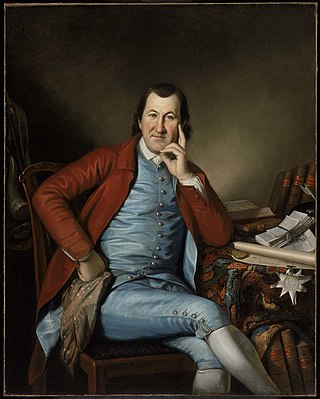Related Research Articles

Henry Laurens was an American Founding Father, merchant, slave trader, and rice planter from South Carolina who became a political leader during the Revolutionary War. A delegate to the Second Continental Congress, Laurens succeeded John Hancock as its president. He was a signatory to the Articles of Confederation and, as president, presided over its passage.

A penal colony or exile colony is a settlement used to exile prisoners and separate them from the general population by placing them in a remote location, often an island or distant colonial territory. Although the term can be used to refer to a correctional facility located in a remote location, it is more commonly used to refer to communities of prisoners overseen by wardens or governors having absolute authority.

William Moultrie was an American slaveowning planter and politician who became a general in the American Revolutionary War. As colonel leading a state militia, in 1776 he prevented the British from taking Charleston, and Fort Moultrie was named in his honor.

The Invasion of Quebec was the first major military initiative by the newly formed Continental Army during the American Revolutionary War. The objective of the campaign was to seize the Province of Quebec from Great Britain, and persuade French-speaking Canadiens to join the revolution on the side of the Thirteen Colonies. One expedition left Fort Ticonderoga under Richard Montgomery, besieged and captured Fort St. Johns, and very nearly captured British General Guy Carleton when taking Montreal. The other expedition, under Benedict Arnold, left Cambridge, Massachusetts, and traveled with great difficulty through the wilderness of Maine to Quebec City. The two forces joined there, but they were defeated at the Battle of Quebec in December 1775.

During the American Revolutionary War (1775–1783), management and treatment of prisoners of war (POWs) were very different from the standards of modern warfare. Modern standards, as outlined in the Geneva Conventions of later centuries, assume that captives will be held and cared for by their captors. One primary difference in the 18th century was that care and supplies for captives were expected to be provided by their own combatants or private resources.

The 8th (King's) Regiment of Foot, also referred to in short as the 8th Foot and the King's, was an infantry regiment of the British Army, formed in 1685 and retitled the King's on 1 July 1881.

Jean-François Hamtramck (1756–1803) was a Canadian who served as an officer in the US Army during the American Revolutionary War and the Northwest Indian War. In the Revolution, he participated in the Invasion of Quebec, the Sullivan Expedition, and the Siege of Yorktown. In the history of United States expansion into the Northwest Territory, Hamtramck is connected to 18th century forts at modern Midwest cities such as Steubenville, Vincennes, Fort Wayne, and Detroit. The city of Hamtramck, Michigan is named for him.

The Illinois campaign, also known as Clark's Northwestern campaign, was a series of engagements during the American Revolutionary War in which a small force of Virginia militia led by George Rogers Clark seized control of several British posts in the Illinois Country of the Province of Quebec, located in modern-day Illinois and Indiana in the Midwestern United States. The campaign is the best-known action of the western theater of the war and the source of Clark's reputation as an early American military hero.

William Crawford was an American military officer and surveyor who worked as a land agent alongside George Washington while Washington was a teenager. Crawford fought in the French and Indian War, Lord Dunmore's War and the American Revolutionary War arising to the rank of Colonel. In 1782, his unit was attacked, and while he and his surgeon escaped for less than one day, Crawford was eventually captured where he was tortured and burned at the stake by Crawford's former soldier turned British agent, Simon Girty, and Captain Pipe, a Chief of the Delaware Nation.

The Battle of the Cedars was a series of military confrontations early in the American Revolutionary War during the Continental Army's invasion of Canada that had begun in September 1775. The skirmishes, which involved limited combat, occurred in May 1776 at and around the Cedars, 45 km (28 mi) west of Montreal, British America. Continental Army units were opposed by a small force of British troops leading a larger force of First Nations warriors and militia.

Timothy Matlack was an American politician, military officer and businessman who was chosen in 1776 to inscribe the original United States Declaration of Independence on vellum. A brewer and beer bottler who emerged as a popular and powerful leader in the American Revolutionary War, Matlack served as Secretary of Pennsylvania during the conflict and a delegate to the Second Continental Congress in Philadelphia in 1780. Matlack was known for his excellent penmanship, and his handwritten copy of the Declaration is on public display in the Rotunda of the Charters of Freedom at the National Archives Building in Washington, D.C.
Bedel's Regiment was first raised as a single company of rangers in Coos, New Hampshire on May 26, 1775 under the command of Timothy Bedel for the protection of northern New Hampshire during the early days of the American Revolutionary War. Between July 1775 and January 1776 eight more companies of rangers were recruited from the frontiermen of northern New Hampshire as the regiment joined the Continental Army and took part in the Siege of Fort St. Jean and the Battle of The Cedars during the Invasion of Canada. Most of the regiment was captured at The Cedars but were exchanged for British soldiers captured during the Canadian campaign eight days later. With the ending of the enlistments of the soldiers the regiment was disbanded on January 1, 1777 at Coos, New Hampshire.
Timothy Bedel was a soldier and local leader prominent in the early history of New Hampshire and Vermont.
Moses Hazen was a brigadier general in the Continental Army during the American Revolutionary War. Born in the Province of Massachusetts Bay, he saw action in the French and Indian War with Rogers' Rangers. His service included particularly brutal raids, during the Expulsion of the Acadians and the 1759 Battle of Quebec. He was formally commissioned into the British Army, shortly before the war ended, and retired on half-pay outside Montreal, Province of Quebec, where he and Gabriel Christie, another British officer, made extensive land purchases in partnership. During his lifetime he acquired land in Quebec, New Hampshire, Vermont, and New York, but lost most of his Quebec land due to litigation, with Christie and the negative effects of the Revolution.

The Crawford expedition, also known as the Sandusky expedition and Crawford's Defeat, was a 1782 campaign on the western front of the American Revolutionary War, and one of the final operations of the conflict. The campaign was led by Colonel William Crawford, a former officer in the U.S. Continental Army. Crawford's goal was to destroy enemy Native American towns along the Sandusky River in the Ohio Country, with the hope of ending Native attacks on American settlers. The expedition was one in a series of raids against enemy settlements that both sides had conducted throughout the war.

Fort Randolph was an American Revolutionary War fort which stood at the confluence of the Ohio and Kanawha Rivers, on the site of present-day Point Pleasant, West Virginia, United States.

John B. McClelland (1734–1782) was an officer in the American Revolutionary War. He was captured by American Indians during the Crawford Expedition and tortured to death at the Shawnee town of Wakatomika, which is currently located in Logan County, Ohio, about halfway between West Liberty, Ohio and Zanesfield, Ohio.
David Mathews was an American born British lawyer and politician from New York City. He was a Loyalist during the American Revolutionary War and was the 43rd and last Colonial Mayor of New York City from 1776 until 1783. As New York City was the center of British control of the Colonies during the war, he was one of the highest ranking civilian authorities in the Colonies during this period. He was accused of supporting a plan led by Thomas Hickey to kill the Revolutionary General George Washington. He resettled in Nova Scotia after the war, and became a leading political figure in the Cape Breton colony that was created in 1786.

William Russell was an army officer and a prominent settler of the southwestern region of the Virginia Colony. He led an early attempt to settle the "Kentuckee Territory". He was a justice of Fincastle County, Virginia. During the American Revolutionary War he fought in the Battle of Yorktown. While a representative in the Virginia House of Delegates, Russell was noted for his stance opposing the 1785 State of Franklin petition for admittance into the United States.
The Battle of Lindley's Fort was part of a campaign by Loyalist and Cherokee forces to gain control over the South Carolina backcountry from Patriot forces early in the American Revolutionary War. The Cherokees were involved because ongoing encroachment of their territory in the area had led them to take up arms. These activities prompted settlers to seek refuge at Lindley's Fort in present-day Laurens County. A joint force of Cherokee and Loyalists adorned with Indian warpaint descended on the fort one day after about 150 militiamen arrived at the stockade fort. The defenders repulsed the attackers, and when they withdrew, made a sortie and pursued them. Two Loyalists were killed and 13 taken prisoner.
References
- ↑ Neimeyer, Charles P. (February 28, 2007). The Revolutionary War. Bloomsbury Academic. ISBN 978-0-313-33228-9.